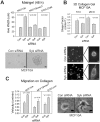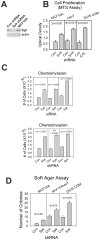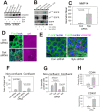Tumor suppressor function of Syk in human MCF10A in vitro and normal mouse mammary epithelium in vivo
- PMID: 19829710
- PMCID: PMC2759536
- DOI: 10.1371/journal.pone.0007445
Tumor suppressor function of Syk in human MCF10A in vitro and normal mouse mammary epithelium in vivo
Abstract
The normal function of Syk in epithelium of the developing or adult breast is not known, however, Syk suppresses tumor growth, invasion, and metastasis in breast cancer cells. Here, we demonstrate that in the mouse mammary gland, loss of one Syk allele profoundly increases proliferation and ductal branching and invasion of epithelial cells through the mammary fat pad during puberty. Mammary carcinomas develop by one year. Syk also suppresses proliferation and invasion in vitro. siRNA or shRNA knockdown of Syk in MCF10A breast epithelial cells dramatically increased proliferation, anchorage independent growth, cellular motility, and invasion, with formation of functional, extracellular matrix-degrading invadopodia. Morphological and gene microarray analysis following Syk knockdown revealed a loss of luminal and differentiated epithelial features with epithelial to mesenchymal transition and a gain in invadopodial cell surface markers CD44, CD49F, and MMP14. These results support the role of Syk in limiting proliferation and invasion of epithelial cells during normal morphogenesis, and emphasize the critical role of Syk as a tumor suppressor for breast cancer. The question of breast cancer risk following systemic anti-Syk therapy is raised since only partial loss of Syk was sufficient to induce mammary carcinomas.
Conflict of interest statement
Figures







References
-
- Coopman PJ, Mueller SC. The Syk tyrosine kinase: a new negative regulator in tumor growth and progression. Cancer Letters. 2006;241:159–173. - PubMed
-
- Muthusamy V, Duraisamy S, Bradbury CM, Hobbs C, Curley DP, et al. Epigenetic silencing of novel tumor suppressors in malignant melanoma. Cancer Res. 2006;66:11187–11193. - PubMed
-
- Liu S, Ren S, Howell P, Fodstad O, Riker AI. Identification of novel epigenetically modified genes in human melanoma via promoter methylation gene profiling. Pigment Cell Melanoma Res. 2008 - PubMed
-
- Moroni M, Soldatenkov V, Zhang L, Zhang Y, Stoica G, et al. Progressive loss of Syk and abnormal proliferation in breast cancer cells. Cancer Res. 2004;64:7346–7354. - PubMed
Publication types
MeSH terms
Substances
Grants and funding
LinkOut - more resources
Full Text Sources
Other Literature Sources
Molecular Biology Databases
Miscellaneous

